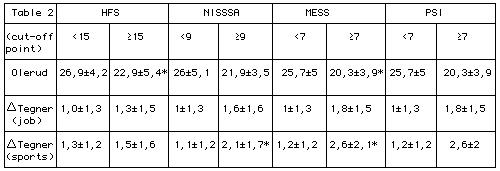
Session III Tibia
Amputation or Reconstruction of Type III B and C Open Tibial Shaft Fractures? - Decision Making Criteria in the Acute Phase and Functional Results
Gerd Regel, MD, Assoc. Prof, Andreas Seekamp, MD, Michael Stalp, MD, Hans-Christoph Pape, MD, Harald Tscherne, MD
Dept. of Trauma Surgery, Hannover Medical School, Hannover, GERMANY
Purpose: Long term results after reconstruction of Type III open tibial shaft fractures have often shown significant functional deficits and prolonged hospitalization in comparison to cases of primary amputation. Therefore several authors have recently looked for adequate criteria concerning the decision of reconstruction vs. amputation in these patients, and have developed the "mangled extremity scores". In our study the goal was to check the reliability of these scoring systems and additionally the functional outcome of both amputees and reconstructed cases in comparable IIIb/c injuries of the tibial shaft.
Methods: The course of medical treatment, e.g. the duration and frequency of operative intervention, the period of intensive care, hospitalization and final rehabilitation were documented. In the follow-up study (x = 4.3 yrs. after trauma), the range of motion (hip, knee, ankle and subtalar joint) was documented and significant deficits were noted (>20% deficit compared to normal). The functional result was also quantified according to the TEGNER score and a modified version of the KARLSTRÖM-OLERUD-score for the lower extremity.
Results: 72 reconstructions, 11 primary and 10 secondary amputations were performed after Type III open tibial shaft fractures between 1/1985 and 12/1992. The soft tissue damage was classified as IIIb in 67 and IIIc in 26 cases. Injury distribution and severity show no significant differences in the 3 groups. 4 established "mangled extremity scores" underwent ROC analysis, showing highest specificity and sensitivity for specific cut-off points: so for instance the prediction for amputation was for the Hannover Fracture Scale = specificity 0.71, sensitivity 0.91 and for the NISSSA score = specificity 0.88, sensitivity 0.78.
Secondary amputations had a significantly longer hospitalization and the worst functional outcome, compared to reconstruction, and primary amputation (TABLE 1.). Even after reconstruction, those cases with an amputation score above the specific cut-off point were functionally poor (TABLE 2.).


HFS=Hannover Fracture Scale according to Südkamp 1989
MESS=Mangled Extremity Severity Score according to Helfet 1990
PSI=Predictive Salvage Index according to Howe 1987
NISSSA =score according to McNamara 1994
Conclusions: This demonstrates the value of these mangled extremity scores for early decision-making. Most cases of delayed (secondary) amputation could have been avoided when using one of these scoring systems. Even in those cases where a "successful" reconstruction could be demonstrated, those with a score above the potential cut-off point were functionally poor and amputation possibly would have improved the outcome of these patients.